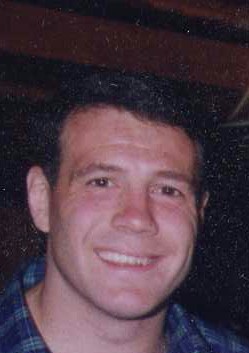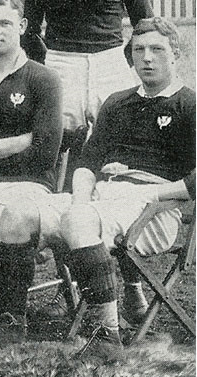
Andrew Gavin Hastings, is a Scottish former rugby union player. A fullback, he is widely regarded to be one of the best ever Scottish rugby players and was one of the outstanding players of his generation, winning 61 caps for Scotland, 20 of which as captain. He played for Watsonians, London Scottish, Cambridge University, Scotland and the British Lions. He twice toured with the Lions, to Australia in 1989 and as captain on the 1993 tour to New Zealand.

Scott Hastings is a Scottish sports commentator and former Scotland international rugby union player. At the point of his retirement he was Scotland's most-capped player ever, but this record has now been beaten. He played for Edinburgh District and when that provincial side turned professional he played for Edinburgh Rugby. At amateur level he played for Watsonians.

Watsonian Football Club is a rugby union club based in Edinburgh and part of the Scottish Rugby Union. The club is connected with George Watson's College as a club for former pupils, and changed its policy in the 1980s to be a fully open club, welcoming players of all abilities regardless of whether they attended the school or not. It is one of a small number of rugby union clubs entitled to call itself a 'football club', rather than a 'rugby football club'. Watsonians run a number of sides; the top male side plays in the FOSROC Super Series tournament, the Women's side plays in the Tennents Scottish Women's Premiership Scottish Rugby's Women's League
Edinburgh University Rugby Football Club is a leading rugby union side based in Edinburgh, Scotland which currently plays its fixtures in the Edinburgh Regional Shield competition and the British Universities Premiership. It is one of the eight founder members of the Scottish Rugby Union. In the years prior to the SRU's introduction of club leagues in 1973 and the advent of professionalism in the 1990s, EURFC was a major club power and it won the 'unofficial' Scottish Club championship several times. It remains a club with an all-student committee, and is only open to students of the University of Edinburgh. The club runs a men's team and a women's team; both playing in the university leagues.
Melrose Sevens is an annual rugby sevens event held by Melrose Rugby Club, at The Greenyards in Melrose, Scotland. It is the oldest rugby sevens competition in the world, dating back to 1883 when the tournament was suggested by former Melrose players Ned Haig and Davie Sanderson. Shogun are the current men and women's holders having won the tournament in 2024.
William Neilson was a Scotland international rugby union player. He was born in Thankerton House in Holytown, near Glasgow, Scotland. Holytown was historically in Bothwell parish leading to some references to state Bothwell.
The 1907 Home Nations Championship was the twenty-fifth series of the rugby union Home Nations Championship. Six matches were played between 12 January and 16 March. It was contested by England, Ireland, Scotland and Wales.
Cameron George Mather is a rugby union footballer who plays in the back row. He won eleven caps for Scotland between 1999 and 2004.

Eric "Puss" MacLeod Milroy was a rugby union player who represented Scotland and Watsonians. He was capped twelve times for Scotland between 1910 and 1914, his first appearance coming as a surprise replacement for the Scottish captain, George Cunningham. He was selected for the 1910 British Isles tour to South Africa after other players were forced to withdraw. Due to illness, he only participated in three matches, and did not take part in any of the tests against South Africa. In 1914, he captained Scotland against Ireland, and against England in the last international match before the outbreak of the First World War.
Alexander William Angus was a Scottish international rugby union and cricket player.

Fraser James Macgregor Brown is a Scotland international rugby union player. He currently plays for Glasgow Warriors in the United Rugby Championship. He plays as a hooker or in the back row.
Peter MacGregor Chalmers LLD was a Scottish architect specialising in country churches, and also being involved in several important restoration schemes.
Gala Sevens is an annual rugby sevens event held by Gala RFC, in Galashiels, Scotland. The Gala Sevens was the second of the Border Sevens tournaments to be instated in 1884, just behind the Melrose Sevens in 1883.
The 1906–07 Scottish Districts season is a record of all the rugby union matches for Scotland's district teams.
The 1910–11 Scottish Districts season is a record of all the rugby union matches for Scotland's district teams.
The Scottish Unofficial Championship was the top league of Scotland's best amateur rugby union clubs. The Championship was 'unofficial' as the Scottish Rugby Union held that the sport should remain amateur and at the time did not sanction competitive games between the clubs.
Dr. William Halliday Welsh (1879-1972) was a Scotland international rugby union player. He became the 58th President of the Scottish Rugby Union.
John MacCallum was a Scotland international rugby union player.

Emily Maud Titterton was an amateur golfer. She won the Womens Amateur Championship on the Old Course at St Andrews in 1908.
John Tod was a Scotland international rugby union player. He was nicknamed 'The Prince of Dribblers' and it is said that he introduced the dribbling game to rugby union. Tod, himself, rated the later Watsonian player and Scotland international William Cownie as a much better dribbler of the rugby ball than he was, saying that Cownie was the prettiest dribbler he had ever seen touch a rugby ball.






